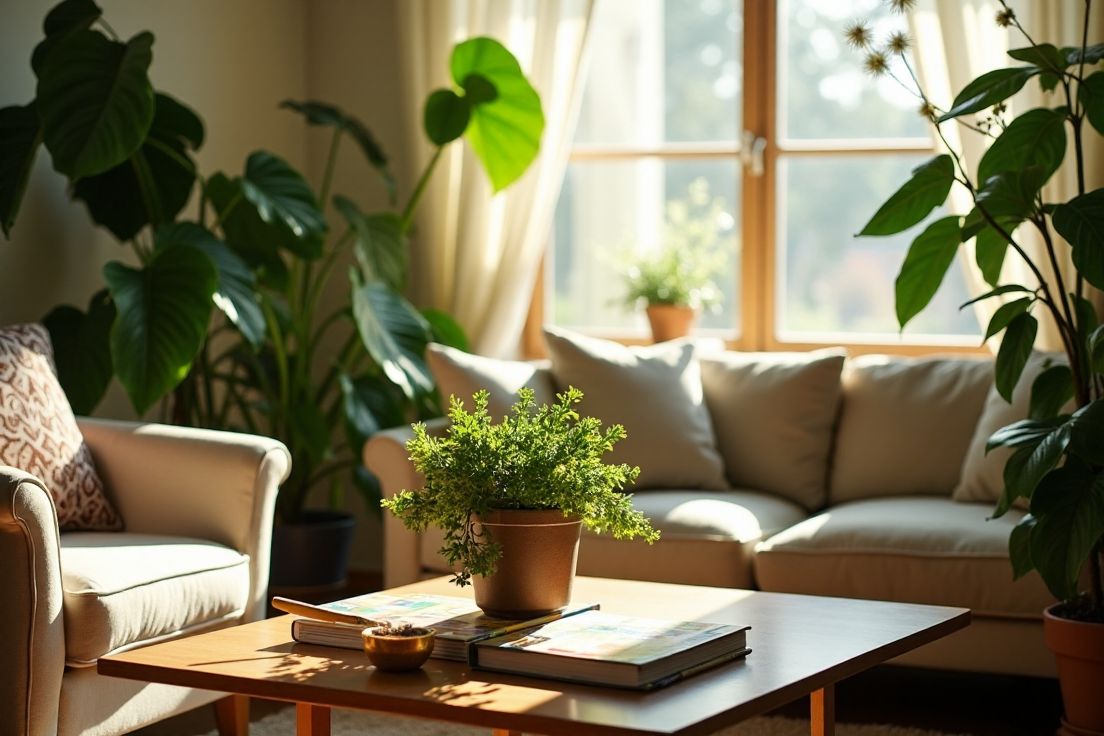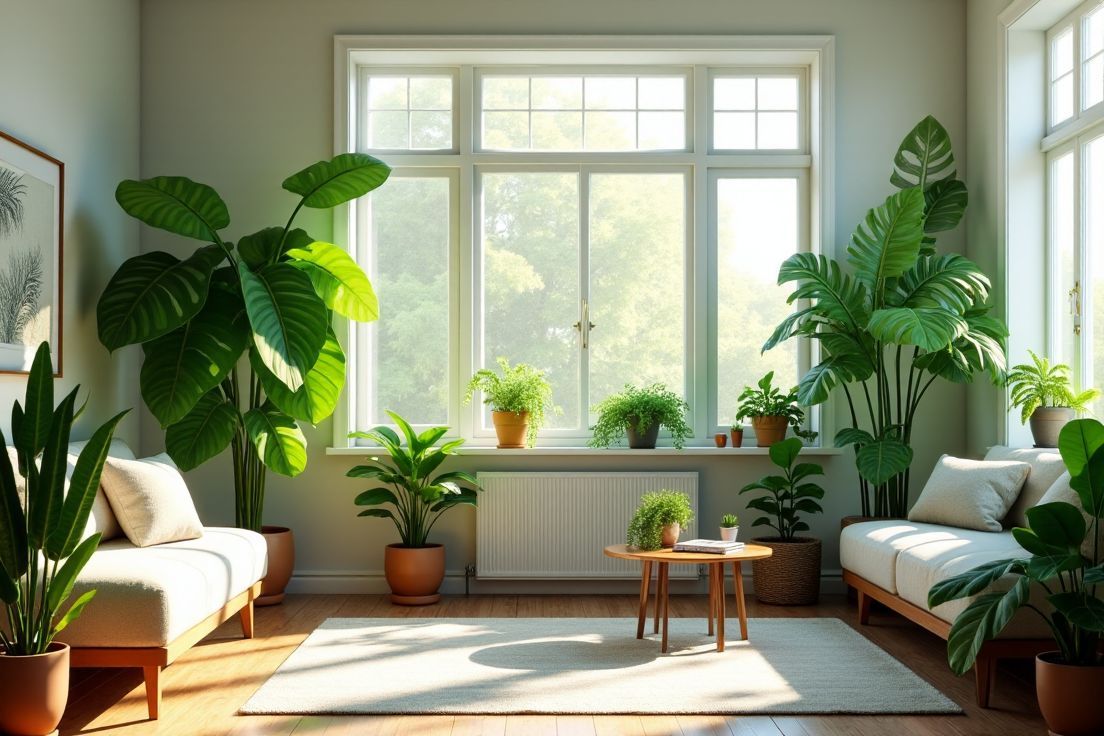Indoor plants can make your home feel warm and inviting. Choosing the right plants is important because they can enhance the look of your space and improve the air quality too.
Before you start picking out plants, it’s essential to think about a few key things. Consider how much natural light different areas in your home receive. Plants like succulents and cacti love bright sunlight, while others, such as snake plants, thrive in low-light conditions.
You should also think about how much space you have and how much time you’re willing to spend on plant care. Some plants are low-maintenance and can survive with little attention, while others may require more regular care.
Selecting Ideal Indoor Greenery for Your Home

Choosing the right indoor plants involves understanding your environment as well as your personal preferences. Light levels play a crucial role in plant health. If a room has bright, direct sunlight, you can opt for plants like succulents and cacti, which thrive in such conditions. For low-light areas, snake plants or pothos are great choices as they can tolerate shade and still look vibrant.
Consider the size of the space as well. Smaller plants can work well on desks or shelves, while larger plants like fiddle leaf figs can serve as statement pieces in corners or near windows. Additionally, think about how much maintenance youre willing to commit to. Some plants require frequent watering and care, while others like ZZ plants are quite hardy and need less attention.
It’s also important to think about humidity levels. If you live in a dry area, tropical plants such as peace lilies might struggle, so you will need to provide extra moisture. On the other hand, if your home is humid, many plants will flourish without any special treatment.
Style matters, too.
Assessing Light Conditions for Optimal Plant Growth
Understanding light levels in your space is key to keeping your plants healthy. Every plant has specific light needs that can affect its growth and appearance. You should start by observing how much natural light your room receives throughout the day. Look at where sunlight enters and how it changes from morning to evening.
This will help you know if a spot is bright, medium, or low light.
Bright light usually means direct sunlight for several hours. Plants like succulents, cacti, and some flowering varieties thrive in these conditions. Medium light areas receive some indirect sunlight.
This table categorizes plants based on their light requirements, including bright, medium, and low light conditions, along with examples of each type.
| Light Level | Characteristics | Examples of Plants |
|---|---|---|
| Bright Light | Direct sunlight for several hours | Succulents, Cacti, Some Flowering Varieties |
| Medium Light | Some indirect sunlight | Pothos, Spider Plant, Peace Lily |
| Low Light | Very little direct sunlight | Snake Plant, ZZ Plant, Cast Iron Plant |
| Filtered Light | Bright light filtered through sheer curtains | Ferns, Calathea, Dracaena |
| Variable Light | Can adapt to both low and bright conditions | Aloe Vera, Rubber Plant, Fiddle Leaf Fig |
Many popular houseplants such as snake plants and pothos can do well in these settings. Low light spots often have little to no direct sunlight. In these places, you might consider plants like ZZ plants or ferns, which can manage with minimal light.
You can also measure light levels with a light meter if you want to be precise.
Selecting Plants Based on Humidity Levels
When choosing plants, humidity can greatly influence their growth and health. Different plants thrive in varying humidity levels. For instance, if your space is very humid, plants like ferns, orchids, and bromeliads will often do exceptionally well. These plants enjoy moisture in the air and can display vibrant leaves when provided with the right conditions.
In contrast, if you are dealing with a drier environment, consider selecting hardy plants that can tolerate less moisture. Succulents and cacti are perfect for low-humidity areas as they store water in their leaves. Other suitable options include snake plants and ZZ plants, which can survive with minimal humidity.
For those who enjoy tropical plants, like monsteras or peace lilies, you may need to increase humidity levels to keep them flourishing.
This can be achieved by misting the leaves regularly or placing a humidifier nearby. Grouping plants together can also create a microenvironment with higher humidity, benefitting all the plants in the area.
Monitoring humidity levels in your home can provide great insight into which plants will thrive. Consider using a hygrometer to check the humidity, ensuring that your selected plants match the moisture conditions they need.
By aligning your plant choices with the humidity in your home, you can keep your indoor garden lush and vibrant.
Understanding Temperature Preferences of Indoor Plants
Temperature is a vital factor to consider when caring for indoor plants. Each variety has a specific temperature range in which it thrives. For many houseplants, the ideal temperature typically falls between 65F to 75F (18C to 24C). Be mindful of extreme fluctuations, as these can stress plants.
Sudden cold drafts from air conditioning or heating vents can lead to damage.
Tropical plants, like fiddle leaf figs and monstera, prefer warmer environments and may struggle if temperatures drop below 60F (15C). Conversely, more resilient varieties such as snake plants can adapt to cooler conditions but still benefit from warmth. Its crucial to know the preferences of your chosen plants to create an optimal setting.
Additionally, night temperatures should be considered. Many plants tolerate a slight drop at night, mirroring natural conditions. However, excessive cold at night can lead to slow growth and weakened plants. Maintaining a consistent temperature throughout the day and night promotes healthy growth and lush foliage.
Selecting Ideal Indoor Flora for Your Home

When selecting plants, it’s essential to consider their compatibility with your existing decor and lifestyle. Think about the colors and textures that will blend well with your homes interior. For a modern look, consider plants with clean lines, such as snake plants or rubber plants. If you prefer a more tropical vibe, lush varieties like monstera or birds of paradise can add vibrancy to your space.
Placement is another critical aspect. Ensure your plants are in locations where they can be admired without being in the way. You might want to group smaller pots together on a coffee table or place larger plants as focal points in empty corners. Observing the flow of your room can help you determine the best spots for maximum enjoyment.
Lastly, think about the types of pots youll use. The right planter can significantly enhance a plant’s presence. Choose materials that complement your decor, but also consider practicality. For example, ensure that pots have proper drainage holes to prevent overwatering, which can lead to root rot.
By carefully considering aesthetic choices, placement, and pot selection, you can create a delightful indoor garden that suits your style and keeps your plants healthy.
Understanding Light Requirements for Different Indoor Plants
Different indoor plants have unique light requirements that are essential for their growth and health. Knowing the needs of your plants helps in choosing the right spot for them. For instance, plants that prefer bright light, such as succulents and cacti, thrive in areas where they receive several hours of direct sunlight. This type of light enhances their vibrant colors and helps them grow strong.
On the other hand, plants that tolerate medium light, like pothos and spider plants, can do well where theres bright, indirect sunlight. This means they can be placed in areas near windows but not directly in the suns intense rays. These plants often have lush foliage and can grow wonderfully in softer lighting conditions.
Low-light plants, such as snake plants and ZZ plants, excel in fewer light conditions.
Understanding the light requirements of plants is essential for ensuring their health and growth. Here are some key points regarding plants that thrive in various lighting conditions:
- Pothos and spider plants flourish in bright, indirect sunlight, making them ideal for placement near windows.
- These medium-light plants typically feature vibrant, lush foliage that enhances indoor aesthetics.
- Direct sunlight can be harsh on these plants, so it’s best to avoid exposing them to intense rays.
- Low-light plants like snake plants and ZZ plants are perfect for areas with minimal natural light, such as offices or rooms without windows.
- Both medium and low-light plants require less frequent watering compared to those that thrive in full sun, as they store moisture more effectively.
They are perfect for spaces like corners or rooms without many windows. These plants generally have less vibrant colors but can still bring greenery and freshness to your home.
Additionally, some plants adapt well to different lighting conditions. Examples include rubber plants and fiddle leaf figs, which can thrive in both low and bright lights.
Placing them in an area that suits their flexible nature can help them flourish without much change.
Regularly observing your plants will provide clues if they need more or less light. For example, if leaves start to yellow or drop off, this might indicate that theyre getting too much direct sunlight. Conversely, if they appear leggy or stretched out, they may be seeking more light.
Being attentive to these signs can help ensure your plants remain healthy and vibrant.
Selecting Ideal Indoor Plants to Enhance Your Living Space
Choosing indoor plants also involves considering the specific size and layout of your space. For larger areas, taller plants such as fiddle leaf figs or rubber trees can fill empty corners, drawing the eye up and creating a sense of height. These plants can make a powerful statement and add drama to the room. On the other hand, if you’re working with limited space, smaller plants can be strategically placed on windowsills, bookshelves, or tabletops, bringing greenery to your home without overwhelming it.
Think about the flow of your living space. Ensure that plant placement doesn’t obstruct pathways or make areas feel cramped. A plant in an awkward position can disrupt the natural flow of movement, so placing them near seating areas or in locations where they wont be bumped into is key. Additionally, consider how plants interact with their environment.
For instance, hanging plants can be a great choice for smaller spaces, taking advantage of vertical space while providing visual interest. They can trail beautifully down from shelves or window sills, drawing the eye without taking up floor space.
When placing larger plants, take into account how much light they will receive. Position them near windows for optimal growth but be aware of how close they are to heating or cooling vents, as this can impact their health.
Similarly, if you have multiple plants, grouping them based on their size and light requirements can create a harmonious display while ensuring each plant receives the right conditions.
Lastly, consider that your space may change over time. Opt for flexible arrangements by using movable plant stands or rolling carts, allowing you to easily adjust the layout as your plants grow or your decor changes. This adaptability will help keep your indoor garden looking fresh and vibrant.
Harmonizing Plant Care with Your Daily Routine
Matching plant care needs with your lifestyle is essential for keeping your indoor garden thriving. Consider how often you are home and how much time you can dedicate to your plants. If you have a busy schedule, low-maintenance plants are ideal. Varieties like snake plants or pothos can survive with minimal attention, making them perfect for those who may forget to water regularly.
To ensure your indoor garden flourishes, it’s important to find the right balance between plant care needs and your personal schedule. Here are some helpful tips:
- Choose plants that suit your availability; low-maintenance varieties are ideal for busy lifestyles.
- Assess your home environment